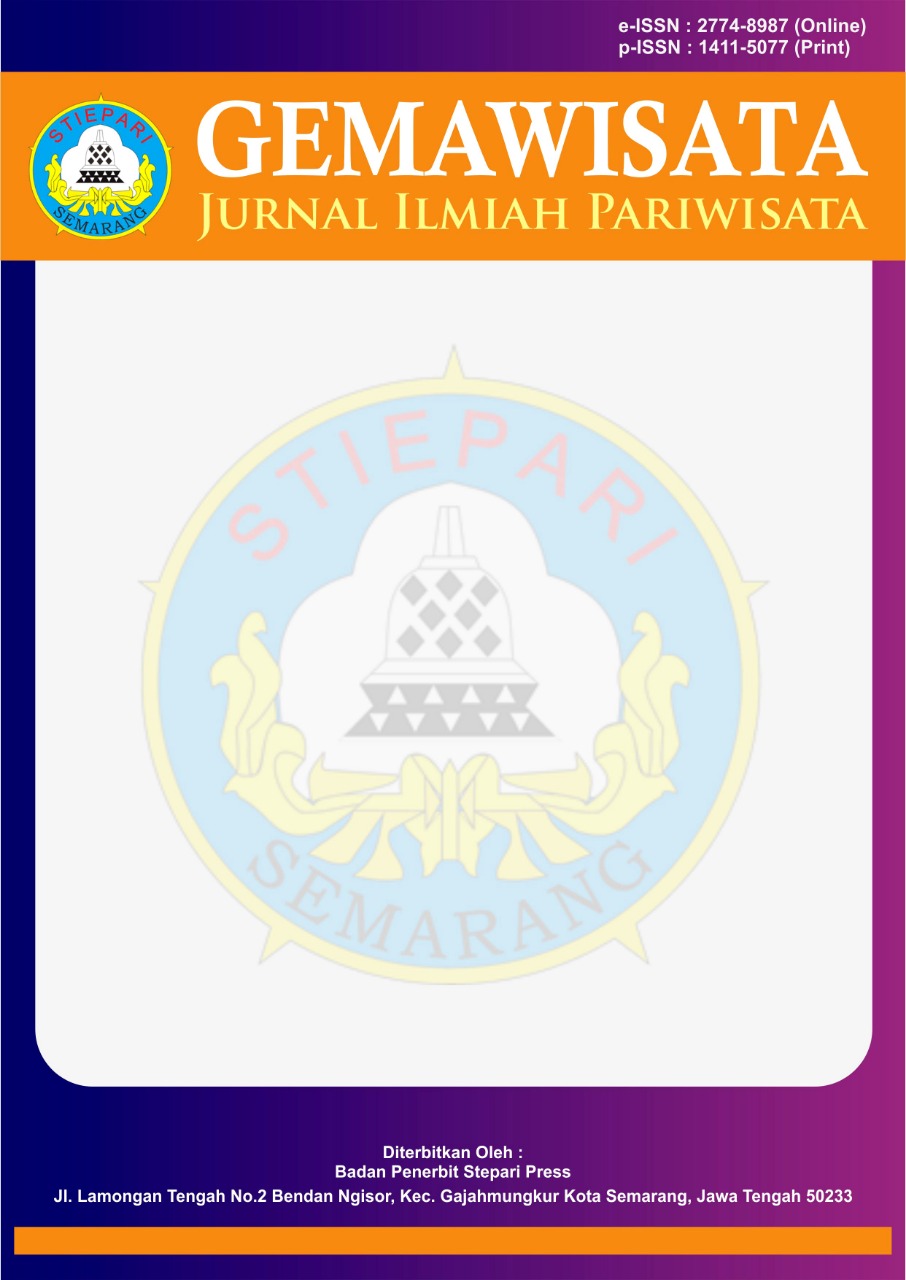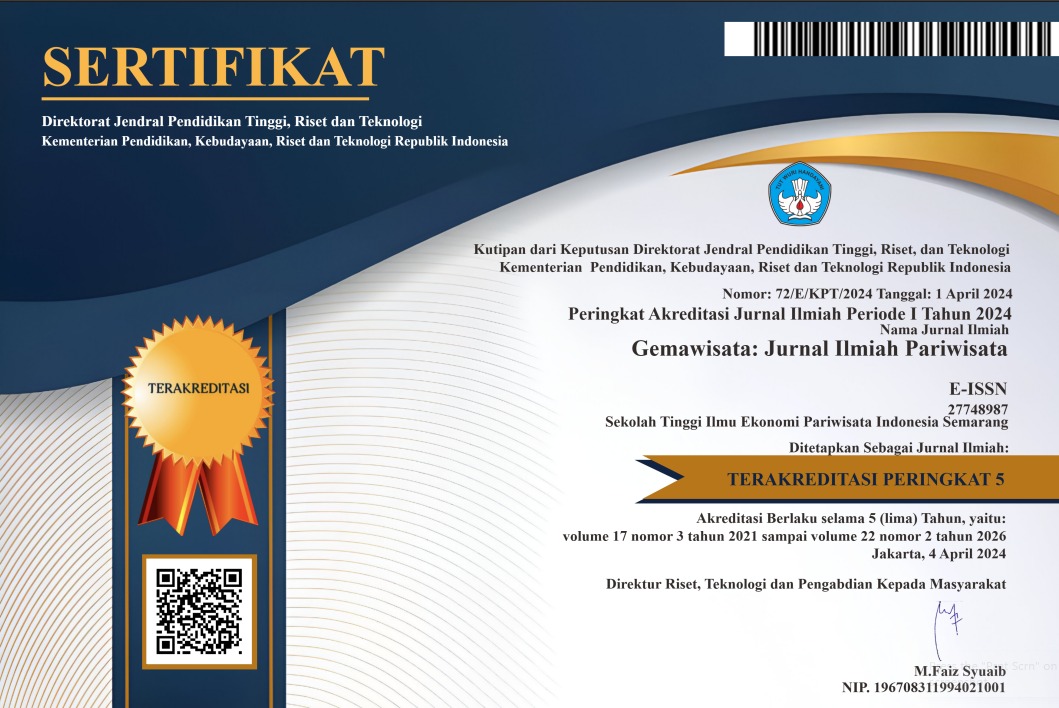Pemanfaatan Teknologi Digital untuk Menjaga dan Memajukan Pusaka Budaya Bali di Mata Dunia
DOI:
https://doi.org/10.56910/gemawisata.v21i2.482Keywords:
Bali Heritage Conservation, Digital Media, Tourism, Augmented Reality TechnologyAbstract
Indonesia has three types of heritage: Cultural Heritage, Natural Heritage, and Saujana Heritage. Cultural Heritage includes unique works from more than 500 ethnic groups, while Natural Heritage is a distinctive natural form. Saujana Heritage is a combination of culture and nature in one unit. This study involved 150 respondents and 2 stakeholders who participated in this study. Data collection techniques used observation, interviews, questionnaires and documentation. The findings of this study are that the preservation of Balinese heritage through digital media faces challenges such as the digital divide, which affects the distribution of cultural information in remote areas in Bali. In addition, maintaining cultural integrity in the digitalization process is important to ensure that original cultural values are not lost. The main challenges in using digital technology to preserve Balinese culture include the digital divide, cultural resistance to new technologies, and the lack of digital literacy among local communities. There are great opportunities in increasing global access to Balinese culture, innovation in cultural tourism, and the development of digital platforms that can promote and preserve Balinese cultural heritage more widely and effectively. The use of social media and tourism applications has proven effective in promoting and preserving Balinese cultural heritage. Social media such as Instagram and Facebook can be used to showcase cultural rituals or traditional ceremonies in real-time, while mobile applications can provide detailed information about Balinese cultural sites.
References
Abdussamad, Z. (2021). Metode penelitian kualitatif. In P. Rapanna (Ed.), Экономика региона (CV. Syakir). Syakir Media Press.
Aidin, A. (2022). Strategi pengembangan wisata cagar budaya perkotaan (urban heritage tourism) di Kota Makassar. Universitas Hasanuddin.
Akbar, R. A., Priyambodo, T. K., Kusworo, H. A., & Fandeli, C. (2020). Digital tourism marketing 4.0 collaborative strategy for Banggai Brothers area, Central Sulawesi, Indonesia. Journal of Education, Society and Behavioural Science, 33(June), 25–38. https://doi.org/10.9734/jesbs/2020/v33i1130269
Ardika, I. W. (2015). Warisan budaya perspektif masa kini. Udayana University Press.
Asmoro, A. Y., Bachri, T. B., & Yusrizal, F. (2021). Studi evaluasi formatif pengelolaan ekowisata ‘Burung Indonesia’ di Mbeliling, Flores. Jurnal Destinasi Pariwisata, 9(1), 1. https://doi.org/10.24843/jdepar.2021.v09.i01.p01
Ayu, R. (2019). Mengenal digitalisasi dalam akuntansi. Cpssoft.Com.
Bhaskara, G. I., & Sugiarti, D. P. (2019). Enhancing cultural heritage tourism experience with augmented reality technology in Bali. E-Journal of Tourism, 6(1), 102. https://doi.org/10.24922/eot.v6i1.47483
Brata, I. B., Rai, I. B., Rulianto, & Wartha, I. B. N. (2020). Pelestarian warisan budaya dalam pembangunan pariwisata Bali yang berkelanjutan. Prosiding Seminar Nasional Webinar Nasional Peranan Perempuan/Ibu dalam Pemberdayaan Remaja di Masa Pandemi Covid-19, 49–60. http://e-journal.unmas.ac.id/index.php/prosidingwebinarwanita/article/view/1241/1053
Effendhie, M. (2019). Arsip, memori, dan warisan budaya. Publikasi dan Pamera Arsip Edisi 2, 1–59.
Febriyantoro, M. T., & Arisandi, D. (2018). Pemanfaatan digital marketing bagi usaha mikro, kecil dan menengah pada era masyarakat ekonomi ASEAN. JMD: Jurnal Riset Manajemen & Bisnis Dewantara, 1(2), 61–76. https://doi.org/10.26533/jmd.v1i2.175
Fernanda, A. B. (2021). Manfaat dan pentingnya digitalisasi di era saat ini. Digitalbisa.id.
Ghozali, I. (2018). Aplikasi analisis multivariate dengan program IBM SPSS 25 (IX). Undip.
Iakovaki, E., Konstantakis, M., Teneketzis, A., & Konstantakis, G. (2023). Analyzing cultural routes and their role in advancing cultural heritage management within tourism: A systematic review with a focus on the integration of digital technologies. Encyclopedia, 3(4), 1509–1522. https://doi.org/10.3390/encyclopedia3040108
Isa, W. M. W., Zin, N. A. M., Rosdi, F., & Sarim, H. M. (2020). Digital preservation of intangible cultural heritage. Indonesian Journal of Electrical Engineering and Computer Science, 12(3), 1373–1379. https://doi.org/10.11591/ijeecs.v12.i3.pp1373-1379
Kasidi, K. (2020). Tantangan kewirausahaan di era ekonomi digital. Journal of Economic Education and Entrepreneurship, 1(1), 17. https://doi.org/10.31331/jeee.v1i1.1223
Khairina, E., Purnomo, E. P., & Malawnai, A. D. (2020). Sustainable development goals: Kebijakan berwawasan lingkungan guna menjaga ketahanan lingkungan di Kabupaten Bantul Daerah Istimewa Yogyakarta. Jurnal Ketahanan Nasional, 26(2), 155. https://doi.org/10.22146/jkn.52969
Kotler, K. (2022). Intisari manajemen pemasaran (Edisi keen). Penerbit Andi.
Kumala, S. A., & Lauder, M. R. (2021). Makna toponim di Tangerang sebagai representasi keberadaan etnis Cina Benteng: Sebuah kajian linguistik historis komparatif. Ranah: Jurnal Kajian Bahasa, 10(2), 304. https://doi.org/10.26499/rnh.v10i2.4048
Kusumawardhana, I. (2023). Pariwisata berkelanjutan dan pemberdayaan masyarakat desa: Studi kasus di Desa Wisata Mas, Kecamatan Ubud, Gianyar. Jurnal Administrasi Pemerintahan Desa, 4(1), 27–55. https://doi.org/10.47134/villages.v4i1.45
Liang, X., Hua, N., Martin, J., Dellapiana, E., Coscia, C., & Zhang, Y. (2022). Social media as a medium to promote local perception expression in China’s world heritage sites. Land, 11(6). https://doi.org/10.3390/land11060841
Lucky, R. P. (2020). Pengaruh pariwisata terhadap peningkatan PDRB Kota Surakarta. Jurnal Pariwisata dan Budaya, 21(Jilid 1), 1–7.
Mangolo, M. C. S., Sukaatmadja, I. P. G., & Pujaastawa, I. B. G. (2017). ‘Waruga’ sebagai daya tarik wisata di Desa Sawangan, Kabupaten Minahasa Utara. Jurnal Master Pariwisata (JUMPA), 4, 120–135. https://doi.org/10.24843/jumpa.2017.v04.i02.p08
Manish Dadhich. (2020). An overview of ancient value and cultural heritage of Bali (Indonesia). International Journal in Management and Social Science, 4(6), 631–636. https://www.academia.edu/27257478/FUTURE_PROSPECTS_OF_E_COMMERCE_IN_INDIA
Manurip, C., & Suwetja, I. G. (2022). Analisis pemahaman dan persepsi etis dari sisi konsultan pajak tentang penghindaran pajak aktif dalam bentuk tax avoidance dan tax evasion. Jurnal LPPM EkoSosBudKum (Ekonomi, Sosial, Budaya dan Hukum), 5(2), 433–430.
Muhardi, Oktini, D., Fadhilah, A., & Aufa, M. (2023). The role of promotional media in developing sustainable mining heritage tourism. Mediator: Jurnal Komunikasi, 16(2), 243–263. https://doi.org/10.29313/mediator.v16i2.3037
Muhasim, M. (2017). Pengaruh teknologi digital terhadap motivasi belajar peserta didik. Palapa, 5(2), 53–77. https://doi.org/10.36088/palapa.v5i2.46
Nanincova, N. (2019). Pengaruh kualitas layanan terhadap kepuasan pelanggan Noach Cafe and Bistro. Agora, 7(2), 1–5. https://media.neliti.com/media/publications/287057-pengaruh-kualitas-layanan-terhadap-kepua-8824929f.pdf
Navarrete, T. (2020). Digital heritage tourism: Innovations in museums. World Leisure Journal, 61(3), 200–214. https://doi.org/10.1080/16078055.2019.1639920
Ni Nyoman Arini, I. Wayan Putra Aditya, I. Wayan Kartimin, & I Putu Tiana Raditya. (2022). Storynomics desa wisata: Promosi desa wisata Munggu berbasis narasi storytelling. Pariwisata Budaya: Jurnal Ilmiah Agama dan Budaya, 7(2), 98–109. https://doi.org/10.25078/pariwisata.v7i2.883
Pemerintah. (2010). Undang-Undang Nomor 11 Tahun 2010 tentang cagar budaya. Jaringan Dokumentasi dan Informasi Hukum, 54, 1–2. https://peraturan.bpk.go.id/Home/Details/38552/uu-no-11-tahun-2010
Permatasari, P. A., Qohar, A. A., & Rachman, A. F. (2020). Cultural heritage tourism: The role of information technology in sustainable development. Journal of Management and Marketing Review, 5(2), 147–157. https://doi.org/10.35609/jmmr.2020.5.2(3)
Putra, S. S., & Sujaya, I. B. (2018). Analisis penerapan metode promosi pada usaha kecil menengah (UKM) produk kerajinan. Jurnal Ilmiah Manajemen dan Bisnis, 1(1), 45–59.
Putri, S. P., & Nuraini, N. (2021). Penerapan digital marketing untuk meningkatkan jumlah pengunjung pada industri kreatif di Kota Tangerang. Journal of Business and Innovation, 2(1), 1–12. https://doi.org/10.37038/jbi.v2i1.123
Putri, W. S., & Fitriani, D. (2020). Konservasi Cagar Budaya di Kabupaten Sleman. Jurnal Kearifan Lokal, 4(1), 1–10.
Suhardi, S., & Ibrahim, R. (2020). Pengembangan desa wisata berbasiskan digital marketing. Jurnal Destinasi Pariwisata, 6(2), 13. https://doi.org/10.24922/jdepar.v6i2.398
Suharjo, A., Syamsudin, A., & Rahman, A. (2019). Pengaruh pariwisata terhadap perekonomian masyarakat Kabupaten Pati. Jurnal Ekonomi Pembangunan, 14(1), 13–24.
Suyadi, E., & Pratama, R. (2022). Digital marketing sebagai strategi untuk meningkatkan daya saing produk UMKM di Kabupaten Nganjuk. Jurnal Ilmu Manajemen dan Akuntansi, 5(1), 55–69.
Tjeng, L. T., & Shinta, E. (2023). Transformasi digital dan dampaknya terhadap keberlanjutan ekonomi desa: Studi kasus pada desa wisata di Yogyakarta. Jurnal Ekonomi, Bisnis, dan Kewirausahaan, 14(2), 175–192.
Zia, A. M. (2019). Effect of digital marketing on tourism: Evidence from Pakistan. Sustainable Development and Planning VIII, 5(3), 351–359. https://doi.org/10.2495/sdp-v5-n3-351-359


1_(1).jpg)






